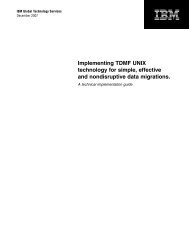A Primer for Healthcare Managers - IBM
A Primer for Healthcare Managers - IBM
A Primer for Healthcare Managers - IBM
Create successful ePaper yourself
Turn your PDF publications into a flip-book with our unique Google optimized e-Paper software.
16<br />
Phase 3: Vendor Selection and Contract<br />
Negotiation<br />
Vendors respond to an organization’s request <strong>for</strong><br />
proposals by submitting proposals. The organization<br />
then reviews these proposals and undertakes the<br />
<strong>for</strong>mal procurement process. It should be understood<br />
that vendor selection sometimes interacts<br />
with the actual contract negotiation. During the<br />
contract negotiation stage, organizations may<br />
request more details about the service package<br />
provided by the vendor.<br />
Both vendor selection and contract negotiation<br />
should follow the general guidelines and parameters<br />
established in phases 1 and 2. These guidelines and<br />
parameters should serve as the working framework<br />
in which the IT outsourcing team operates. For<br />
example, if security and improvement of current IT<br />
service are the top two strategic concerns<br />
of the outsourcing organization, then it should look<br />
<strong>for</strong> a vendor that has strong security measures <strong>for</strong><br />
their IT services and that delivers a state-of-the-art<br />
service package <strong>for</strong> improvement of existing<br />
services within the organization. On the other hand,<br />
if an outsourcing organization operates in<br />
a relatively uncertain environment, the contract<br />
negotiated should have a provision dealing with that<br />
uncertainty of service needs.<br />
Vendor selection<br />
Several general criteria are important <strong>for</strong> selecting<br />
the right vendor. The first important one is the<br />
alignment between the business solution <strong>for</strong> the<br />
client organization and the vendor’s business objectives<br />
(Embleton and Wright, 1998, p.1). The mutual<br />
long-term benefits will help sustain a long-term relationship.<br />
Since the specific type of IT service is the<br />
major strength of the vendor, the vendor is more<br />
likely to maintain its market position. As a result, the<br />
outsourced organization is more likely to have stable<br />
and quality service from the vendor.<br />
Criteria <strong>for</strong> Vendor Selection<br />
• Good strategic alignment between the<br />
organization and its vendors<br />
• Appropriate skill set on vendor side<br />
• Reliability<br />
• Availability of security and in<strong>for</strong>mation<br />
assurance package<br />
• Ability to integrate various systems and<br />
deploy new technologies<br />
Another important criterion is having the appropriate<br />
skill set available at the vendor <strong>for</strong> achieving the<br />
agency’s strategic objectives. For many organizations,<br />
the main reason <strong>for</strong> outsourcing is to gain<br />
an advanced IT capability that is not available<br />
in-house. There<strong>for</strong>e, it is important to ensure that<br />
the skill set available at the vendor is appropriate <strong>for</strong><br />
providing the advanced IT capability needed.<br />
Reliability is also key to successful IT outsourcing<br />
(Ware, 2002). Organizations should look <strong>for</strong> market<br />
leaders and established players to ensure some<br />
level of reliability. Organizations need to validate<br />
the reliability claim made by the vendors competing<br />
<strong>for</strong> the IT outsourcing contract. One method is to<br />
conduct on-site visits with vendors to have them<br />
demonstrate the reliability of their services.<br />
Moreover, a qualified vendor needs to have a good<br />
security package <strong>for</strong> the IT services it offers. A security<br />
package includes both technical and managerial<br />
aspects. The hardware, software, and facilities that<br />
secure production and delivery of services are<br />
considered the technical aspects. For technical<br />
considerations, one good source of in<strong>for</strong>mation on<br />
in<strong>for</strong>mation assurance products is the in<strong>for</strong>mation<br />
assurance directorate detailing the national policy<br />
regarding the evaluation of commercial in<strong>for</strong>mation<br />
assurance (IA) products. The management system<br />
deals with a comprehensive vulnerability analysis,<br />
security warning system, and procedures safeguarding<br />
security. A vulnerability analysis establishes<br />
an inventory of sources of threat to the in<strong>for</strong>mation<br />
system and/or network in question, including external<br />
and internal threats. The vendor should have an in<strong>for</strong>mation<br />
security policy in place and documentation<br />
that such a policy is actually being followed.<br />
To address the risks associated with market and<br />
technological changes, system integrators or<br />
providers offering comprehensive packages are<br />
preferred. System integrators are useful <strong>for</strong> cushioning<br />
against constant changes in technologies and<br />
are likely to be more independent in choosing the<br />
appropriate combination of software programs <strong>for</strong><br />
their clients. Their independence is particularly<br />
strong when compared with software vendors who<br />
also play the role of service providers. System<br />
integrators are able to upgrade IT services based on<br />
what is available on the market because their business<br />
focus is on meeting client organizations’ needs

















